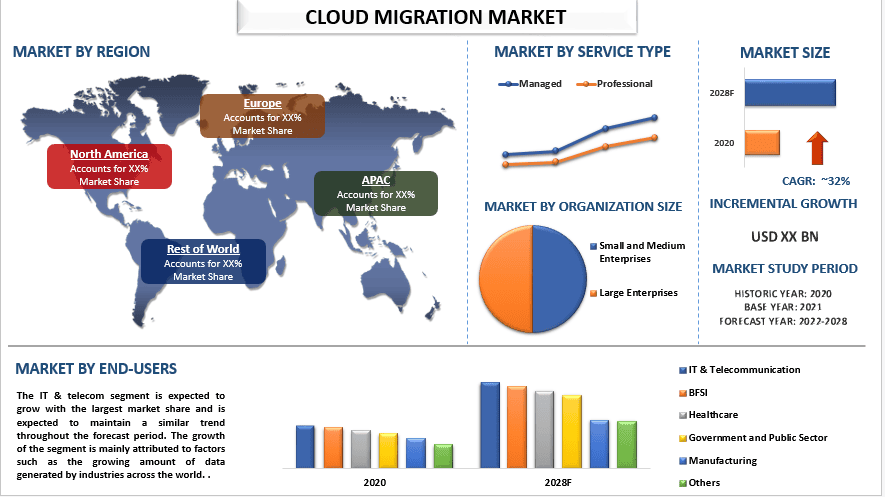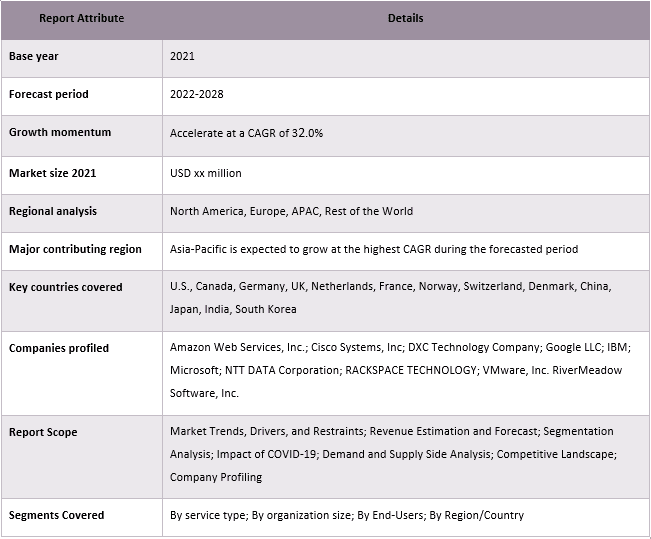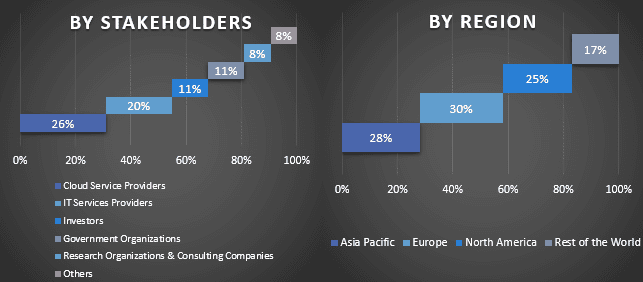- Accueil
- À propos de nous
- Industrie
- Services
- Lecture
- Contactez-nous
Marché de la migration vers le cloud : analyse actuelle et prévisions (2022-2028)
Accent mis sur le type de service (géré et professionnel) ; taille de l'organisation (petites et moyennes entreprises) ; utilisateurs finaux (IT & Télécom, BFSI, santé, secteur public et gouvernemental, fabrication et autres) région/pays

Le marché de la migration vers le cloud devrait croître à un fort TCAC d'environ 32 % au cours de la période de prévision, en raison de la sensibilisation croissante des clients, de la prolifération de l'IoT dans les économies émergentes, de l'augmentation des revenus disponibles et de l'urbanisation. Le marché de la migration vers le cloud a connu une croissance rapide au cours des dernières années, car de plus en plus d'entreprises cherchent à migrer leurs opérations vers le cloud pour une efficacité accrue, des économies de coûts et une évolutivité. Cette tendance devrait se poursuivre à mesure que la technologie cloud devient plus avancée et que les avantages de la migration vers le cloud sont plus largement reconnus, ce qui entraînera la croissance du marché de la migration vers le cloud. En outre, le marché de la migration vers le cloud est très concurrentiel, avec un large éventail de fournisseurs offrant divers services et solutions pour aider les entreprises à effectuer leur transition vers le cloud. Les principaux acteurs du marché sont Amazon Web Services, Microsoft Azure, Google Cloud Platform, IBM Cloud et Oracle Cloud, entre autres. De plus, le nombre croissant de jeunes entreprises technologiques devrait également stimuler le marché au cours de la période de prévision. Par exemple, selon Business Standards, près de 1 400 jeunes entreprises uniques ont reçu un financement en 2022 en Inde. Une croissance de 18 % par rapport à l'année dernière
Parmi les principaux acteurs opérant sur le marché, on trouve Amazon Web Services, Inc. ; Cisco Systems, Inc ; DXC Technology Company ; Google LLC ; IBM ; Microsoft ; NTT DATA Corporation ; RACKSPACE TECHNOLOGY ; VMware, Inc. Plusieurs fusions et acquisitions ainsi que des partenariats ont été entrepris par ces acteurs pour offrir aux clients des produits/technologies de haute technologie et innovants.
Aperçus présentés dans le rapport
« Parmi les types de services, le segment des services gérés détenait une part dominante du marché en 2021 »
Sur la base du type de service, le marché est segmenté en services gérés et professionnels. Le segment des services gérés devrait obtenir la plus grande part de marché en 2021 et devrait également maintenir la même tendance de croissance au cours de la période de prévision. La croissance du segment est attribuée au besoin croissant d'expertise pour le déploiement du cloud. De plus, la tendance croissante du déploiement du cloud dans tous les secteurs devrait influencer de manière significative la croissance du marché au cours de la période de prévision.
« Parmi les tailles d'organisation, les petites et moyennes entreprises devraient croître avec le TCAC le plus élevé »
Selon la taille de l'organisation, le marché est segmenté en petites et moyennes entreprises et en grandes entreprises. Le segment des petites entreprises devrait croître avec le TCAC le plus élevé au cours de la période de prévision. L'une des principales raisons pour lesquelles les petites organisations choisissent de migrer vers le cloud est de réduire leurs coûts d'infrastructure informatique. En migrant vers le cloud, les organisations peuvent éviter les coûts initiaux d'acquisition et de maintenance du matériel et des logiciels, ainsi que les dépenses opérationnelles courantes telles que l'électricité, le refroidissement et la maintenance.
« L'Amérique du Nord a dominé le marché de la migration vers le cloud en 2021. »
Les principaux moteurs de la migration vers le cloud en Amérique du Nord sont la réduction des coûts, l'évolutivité, l'agilité et la transformation numérique. Le cloud computing offre aux organisations la possibilité d'augmenter ou de réduire les ressources en fonction de la demande, ce qui permet une utilisation plus efficace des ressources et des économies de coûts. De plus, l'agilité fournie par le cloud computing permet aux organisations de répondre rapidement aux changements du marché et de développer et de déployer rapidement de nouvelles applications et de nouveaux services. Enfin, la migration vers le cloud prend en charge les initiatives de transformation numérique en fournissant l'infrastructure et les outils nécessaires pour prendre en charge les expériences numériques modernes, telles que les applications mobiles et Web, les appareils IoT et l'IA et l'apprentissage automatique.
Couverture du rapport sur le marché de la migration vers le cloud

Raisons d'acheter ce rapport :
- L'étude comprend une analyse de dimensionnement et de prévision du marché validée par des experts clés authentifiés du secteur.
- Le rapport présente un aperçu rapide de la performance globale de l'industrie en un coup d'œil.
- Le rapport couvre une analyse approfondie des principaux pairs de l'industrie en mettant l'accent sur les principales données financières de l'entreprise, les portefeuilles de produits, les stratégies d'expansion et les développements récents.
- Examen détaillé des moteurs, des contraintes, des tendances clés et des opportunités qui prévalent dans l'industrie.
- L'étude couvre de manière exhaustive le marché à travers différents segments.
- Analyse approfondie au niveau régional de l'industrie.
Options de personnalisation :
Le marché mondial de la migration vers le cloud peut être personnalisé davantage selon les besoins ou tout autre segment de marché. En outre, UMI comprend que vous pouvez avoir vos propres besoins commerciaux, alors n'hésitez pas à communiquer avec nous pour obtenir un rapport qui convient parfaitement à vos besoins.
Table des matières
Méthodologie de recherche pour l'analyse du marché de la migration vers le cloud (2022-2028)
L'analyse du marché historique, l'estimation du marché actuel et la prévision du marché futur du marché mondial de la migration vers le cloud ont été les trois principales étapes entreprises pour créer et analyser l'adoption de la migration vers le cloud dans les principales régions du monde. Une recherche secondaire exhaustive a été menée pour collecter les chiffres du marché historique et estimer la taille actuelle du marché. Deuxièmement, pour valider ces informations, de nombreux résultats et hypothèses ont été pris en compte. De plus, des entretiens primaires exhaustifs ont également été menés avec des experts de l'industrie tout au long de la chaîne de valeur du marché mondial de la migration vers le cloud. Après l'hypothèse et la validation des chiffres du marché par le biais d'entretiens primaires, nous avons employé une approche descendante/ascendante pour prévoir la taille complète du marché. Par la suite, des méthodes de ventilation du marché et de triangulation des données ont été adoptées pour estimer et analyser la taille du marché des segments et sous-segments de l'industrie concernée. La méthodologie détaillée est expliquée ci-dessous :
Analyse de la taille du marché historique
Étape 1 : Étude approfondie des sources secondaires :
Une étude secondaire détaillée a été menée pour obtenir la taille historique du marché de la migration vers le cloud grâce à des sources internes à l'entreprise telles que les rapports annuels et états financiers, présentations des performances, communiqués de presse, etc., et des sources externes, notamment les revues, les actualités et articles, les publications gouvernementales, les publications des concurrents, les rapports sectoriels, les bases de données tierces et autres publications crédibles.
Étape 2 : Segmentation du marché :
Après avoir obtenu la taille historique du marché de la migration vers le cloud, nous avons mené une analyse secondaire détaillée pour recueillir des informations sur le marché historique et partager les différents segments et sous-segments des principales régions. Les principaux segments inclus dans le rapport sont le type de service, la taille de l'organisation et les utilisateurs finaux. D'autres analyses au niveau des pays ont été menées pour évaluer l'adoption globale des modèles de test dans cette région.
Étape 3 : Analyse des facteurs :
Après avoir acquis la taille historique du marché des différents segments et sous-segments, nous avons mené une analyse des facteurs détaillée pour estimer la taille actuelle du marché de la migration vers le cloud. De plus, nous avons effectué une analyse des facteurs à l'aide de variables dépendantes et indépendantes telles que le type de service, la taille de l'organisation et les utilisateurs finaux du marché de la migration vers le cloud. Une analyse approfondie a été menée pour les scénarios de demande et d'offre, en tenant compte des principaux partenariats, fusions et acquisitions, de l'expansion des activités et des lancements de produits dans le secteur du marché de la migration vers le cloud à travers le monde.
Estimation et prévision de la taille actuelle du marché
Détermination de la taille actuelle du marché : Sur la base des informations exploitables tirées des 3 étapes ci-dessus, nous sommes arrivés à la taille actuelle du marché, aux principaux acteurs du marché mondial de la migration vers le cloud et aux parts de marché des segments. Toutes les parts de pourcentage requises et les ventilations du marché ont été déterminées à l'aide de l'approche secondaire susmentionnée et ont été vérifiées par le biais d'entretiens primaires.
Estimation et prévision : Pour l'estimation et la prévision du marché, des pondérations ont été attribuées à différents facteurs, notamment les moteurs et les tendances, les contraintes et les opportunités offertes aux parties prenantes. Après avoir analysé ces facteurs, les techniques de prévision pertinentes, c'est-à-dire l'approche descendante/ascendante, ont été appliquées pour parvenir à la prévision du marché pour 2028 pour différents segments et sous-segments sur les principaux marchés mondiaux. La méthodologie de recherche adoptée pour estimer la taille du marché comprend :
- La taille du marché de l'industrie, en termes de revenus (USD) et le taux d'adoption du marché de la migration vers le cloud sur les principaux marchés nationaux
- Toutes les parts de pourcentage, les divisions et les ventilations des segments et sous-segments de marché
- Les principaux acteurs du marché mondial de la migration vers le cloud en termes de produits proposés. De plus, les stratégies de croissance adoptées par ces acteurs pour concurrencer sur le marché en croissance rapide
Validation de la taille et de la part du marché
Recherche primaire : Des entretiens approfondis ont été menés avec les principaux leaders d'opinion (KOL), y compris les cadres supérieurs (CXO/VP, responsable des ventes, responsable du marketing, responsable des opérations, responsable régional, responsable national, etc.) dans les principales régions. Les résultats de la recherche primaire ont ensuite été résumés et une analyse statistique a été effectuée pour prouver l'hypothèse énoncée. Les informations issues de la recherche primaire ont été consolidées avec les résultats secondaires, transformant ainsi les informations en connaissances exploitables.
Répartition des participants primaires dans différentes régions

Ingénierie du marché
La technique de triangulation des données a été employée pour compléter l'estimation globale du marché et pour obtenir des chiffres statistiques précis pour chaque segment et sous-segment du marché mondial de la migration vers le cloud. les données ont été divisées en plusieurs segments et sous-segments après avoir étudié divers paramètres et tendances dans les domaines du type de service, de la taille de l'organisation et des utilisateurs finaux du marché mondial de la migration vers le cloud.
L'objectif principal de l'étude du marché mondial de la migration vers le cloud
Les tendances actuelles et futures du marché mondial de la migration vers le cloud ont été mises en évidence dans l'étude. Les investisseurs peuvent acquérir des connaissances stratégiques pour fonder leur discrétion en matière d'investissements sur l'analyse qualitative et quantitative effectuée dans l'étude. Les tendances actuelles et futures du marché ont déterminé l'attractivité globale du marché au niveau régional, offrant ainsi une plate-forme au participant industriel pour exploiter le marché inexploité afin de bénéficier d'un avantage de premier arrivé. Les autres objectifs quantitatifs des études comprennent :
- Analyser la taille actuelle et prévisionnelle du marché de la migration vers le cloud en termes de valeur (USD). De plus, analyser la taille actuelle et prévisionnelle du marché des différents segments et sous-segments
- Les segments de l'étude comprennent les domaines du type de service, de la taille de l'organisation et des utilisateurs finaux
- Définir et analyser le cadre réglementaire de la migration vers le cloud
- Analyser la chaîne de valeur impliquée avec la présence de divers intermédiaires, ainsi qu'analyser les comportements des clients et des concurrents de l'industrie
- Analyser la taille actuelle et prévisionnelle du marché de la migration vers le cloud pour la région principale.
- Les principaux pays des régions étudiées dans le rapport comprennent l'Asie-Pacifique, l'Europe, l'Amérique du Nord et le reste du monde
- Profils d'entreprises du marché de la migration vers le cloud et les stratégies de croissance adoptées par les acteurs du marché pour se maintenir sur le marché en croissance rapide
- Analyse approfondie au niveau régional de l'industrie
Connexes Rapports
Les clients qui ont acheté cet article ont également acheté










